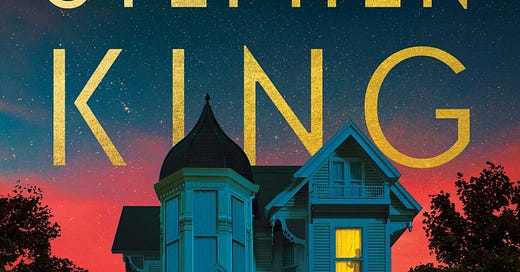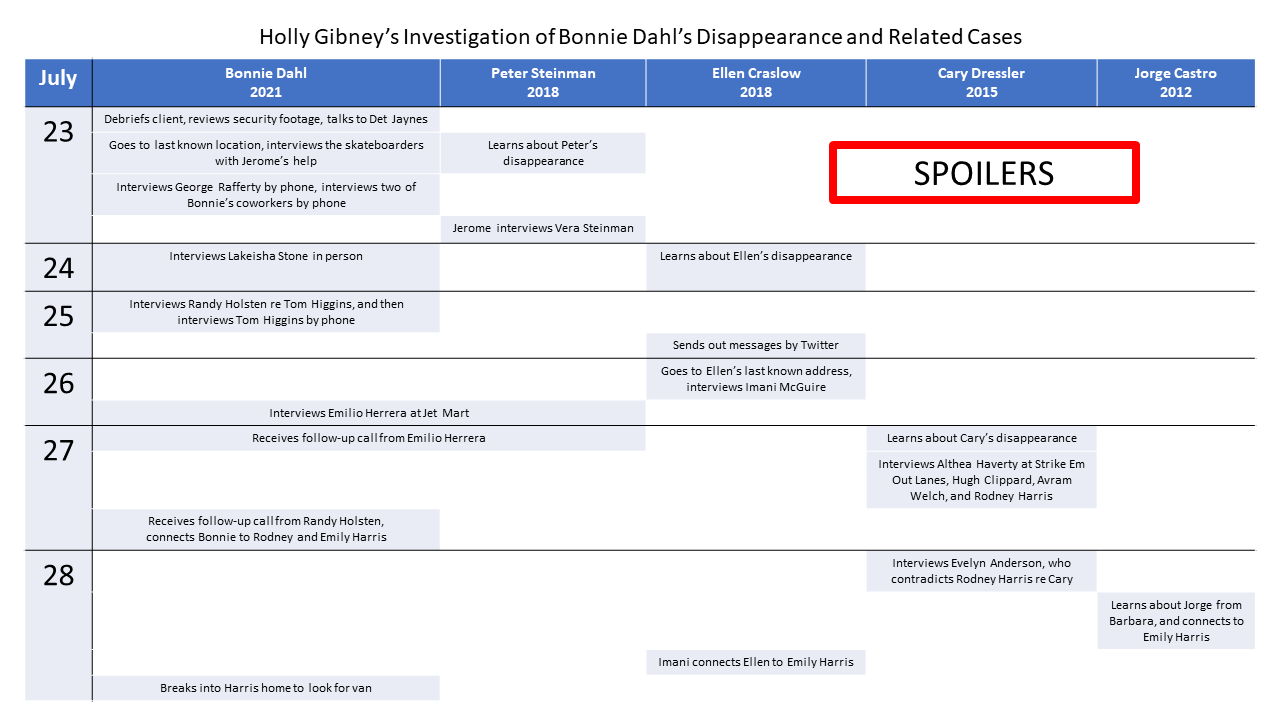Holly: Notes on an Investigation
How Stephen King's Holly Gibney solves her case using solid investigative techniques and strategies
I have loved seeing Stephen King’s Holly Gibney grow as an investigator over the Bill Hodges trilogy, the Outsider, If It Bleeds, and the recent novel Holly. If you’ve read Holly, here are my thoughts as a former prosecutor about some of the investigative and legal aspects of this great story.
SPOILER ALERT
First, Holly’s investigation of the disappearance of Bonnie Dahl is a very good example of an important investigative tactic.
Holly does what she can to investigate Bonnie’s disappearance, but she did not have a lot to work with, and she would not have solved the case if she had not broadened the investigation to similar cases that turned out to be related. By expanding the investigation, she was able to find patterns and other evidence that pointed her to the right suspect and that strengthened what otherwise would have been a very weak case.
Investigating Bonnie’s case leads to the disappearances of Peter Steinman, Ellen Craslow, and Cary Dressler. Investigating Cary’s disappearance eventually points to Rodney Harris, who lies about his relationship with Cary and thus shows that he is hiding something. Investigating Ellen’s disappearance eventually points to Emily Harris, whom Imani McGuire saw cleaning out Ellen’s trailer.
By the time Holly wrote up her investigative report, her evidence about Bonne’s disappearance was still thin, but a lot better when viewed in conjunction with the evidence from Ellen’s case and Cary’s case. The chart below shows Holly’s investigation broken out by case and day – as you can see, she did not actually have much in each particular case, but most pointed to Rodney and Emily Harris, enough to at least raise suspicions.
When I was a prosecutor, I saw this happen in many types of cases. We might not be able to solve one specific bank robbery entirely on its own, but we could piece together enough evidence from a series of related bank robberies to catch the robber and win a conviction. A fraudster might be able to get away with fooling one victim one time, but we could prove our case by finding other victims and then finding overall patterns.
Keep this in mind if you’re investigating something or trying to prove something. What you’re trying to solve or prove might be impossible to solve as a standalone case. But is there another way to help you get to the same point? Is there another crime or incident that you could investigate and that could help build a stronger overall case?
Second, Holly is thrown rope by the universe a few times when witnesses remember helpful facts, but that’s not just luck. Holly interviewed key witnesses in person, rather than by phone – this takes a lot more time, but it can pay off as it does here.
By meeting Lakeisha Stone, Randy Holsten, Imani McGuire, Emilio Herrera, and others in person, Holly made personal connections and got details that she might not have gotten over a phone call or a Zoom. And these people were more willing to tell her the things they remember afterwards and to take follow-up questions, including the key breaks that lead Holly to Rodney and Emily Harris.
When I was a prosecutor, I regularly reminded witnesses that I was asking them about things that they might not have thought about in years, and I said that they likely would remember something a day or two later because my questions had jogged their memory. I sometimes got amazing new leads or evidence afterwards, just like Holly did.
Don’t just send questions by email or text, and don’t just have a quick call. Go knock on doors and try to start a conversation. And when the witness says something that you were not expecting, follow the lead even if you don’t see an immediate connection to what you’re trying to look into. If Holly had not asked about Stinky or Ellen or other disappearances, she would never have solved Bonnie’s disappearance.
Third, what would have happened if Holly had not been captured by the Harrises? Her capture heightens the drama and danger for Holly, but it also sidesteps what could have been a legal slog and a less satisfying ending. Ironically, the Harrises might have gotten away with their crimes if they had not attempted to capture Holly, as their attempts to cover up quickly went awry.
Again, Holly had done a great job connecting multiple disappearances to the Harrises, but it would not have been enough to get them arrested for any of them. Yes, there’s a pattern, but it’s far from beyond a reasonable doubt (the standard for a conviction) and probably not even probable cause (the standard for an arrest).
That’s why Holly knew it was important to get photos of the van. Those photos might have been enough to bring them in for questioning as to why they have a disability van with a fake license plate, and it may even have been enough to get a warrant for at least the van or the garage. Solve one difficult crime by trying to solve an easier, simpler one, even if it’s not the one you really care about.
And even if the evidence was not quite good enough to get a warrant, Detective Izzy Jaynes would have been able to start investigating Rodney and Emily Harris herself. Izzy could have interviewed the Harrises about Bonnie and Ellen and Cary and Jorge, and she would have been able to use subpoenas and get evidence that Holly could not. The Harrises likely would have invoked their Fifth Amendment rights, destroyed evidence, and used their cyanide pills before Izzy could build a strong enough case against them to arrest them, but at least they would not have taken anyone again.
Finally, there are a few legal instances that I wanted to explain:
When Barbara is trying to find Holly, Barbara thinks that she cannot call the police until 24 hours have passed. See page 404 of the Scribner hardcover edition. This is a common belief, but it’s actually a dangerous myth, as there is no such requirement. If you really believe someone is missing, you can and should call the police as soon as possible. Waiting 24 hours loses valuable time.
Holly did violate the law when she broke into the Harrises’ garage, but what she found would probably still be admissible in court if there were a criminal case. The Fourth Amendment protects you from warrantless searches of your home, but only when the searches are done by the government, such as a police officer. Holly is not an agent of the government, so her illegal search did not violate the Fourth Amendment and the evidence she found would likely have been admissible in court. Holly might face other consequences, but it is unlikely she actually would be prosecuted herself for breaking and entering if she was right.
When police go into the Harrises’ basement and find Holly in a cage, Izzy tells officers to break down the door to their operating room, saying, “You better bust that. I’m pretty sure I heard someone inside.” See page 422 of the Scribner hardcover edition. This was a lie to justify breaking into the adjoining room without waiting for a warrant. When the police entered the house, they did not have a warrant but were responding to an emergency. The emergency seemed resolved with the death of the Harrises, so the police arguably did not have justification to search a locked room, though I think they would have been fine if they had. First, there were legitimate concerns about safety given the very disturbing situation in the basement, and they could search the entire house at least to see if there was an accomplice hiding somewhere. Second, the only people who could have objected to an illegal search of the house were the owners of the house, and they were clearly dead.
Izzy refers to a “private grand jury,” but this seems to be conflating two separate concepts: (1) an investigation by a coroner into the cause of death and (2) a grand jury investigation of possible crimes. A grand jury likely would consider whether to bring criminal charges, and its proceedings would be secret, but it’s possible that no grand jury would be called since the two possible targets are already dead and thus cannot be charged.
When debriefed, Holly makes clear that she killed the Harrises in self-defense. Easy calls there. Even though Emily Harris was out of bullets when Holly killed her, Emily would have gotten another gun or killed Holly another way if Holly had not broken her neck. Good for her.
Overall, a great mystery that showcases solid investigating by Holly. I’m already looking forward to what Holly does next!
About the Author: I was a federal prosecutor for 11 years (2008-19) and am now a solo practitioner focusing on health care fraud, white-collar criminal defense, and data analytics in litigation. I was a reporter for the Chicago Tribune and once ran a website that reverse-engineered TV shows to explain the references to news and current events. I have also written about Sherlock Holmes and was recently invested as a member of the Baker Street Irregulars.





